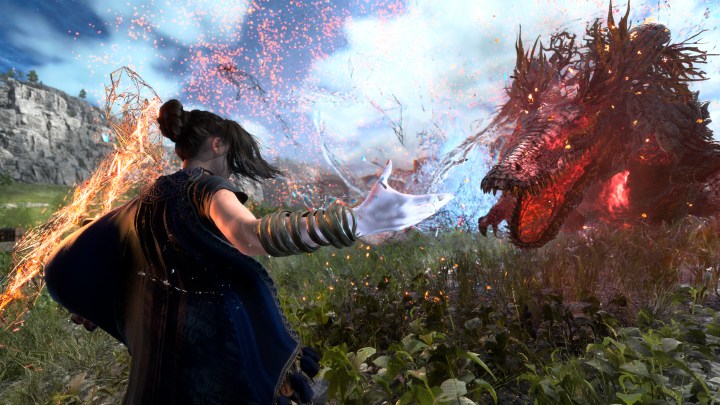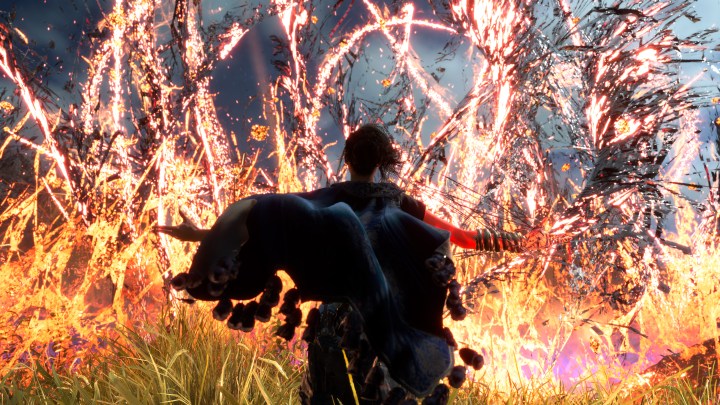When I first went hands-on with Forspoken earlier this year, I didn’t get a sense of its world. I don’t mean its open-world — I saw plenty of that as I zipped around its rolling hills like Sonic the Hedgehog. Rather, I didn’t learn much about Athia beyond its gorgeous landscapes. All I got to see was a promising playground that gave me plenty of excuses to sling spells at wandering monsters. It was dazzling, but what was I doing here?
My missing context was filled in with a more recent and much longer demo. While the build I played in October dropped me into its open-ended seventh chapter and focused on its systems, this slice was more focused on building the story. I’d learn who Frey, the game’s wise-talking protagonist, is and even gain insight into the political turmoil in Athia. I walked out of my four-hour session with no ambiguity about what it was.
The contrast between the two demos speaks to an overall balancing act that developer Luminous Productions is trying to land here. Yes, Forspoken is your typical open-world game filled with a map full of activities to complete. However, it’s also aiming to tell a rich fantasy story through more direct sequences that weave together its open-ended segments. That approach (coupled with some spectacular visuals) has me intrigued by what could be a strong setup for Square Enix’s next big franchise.
Welcome to Athia
In this slice, my journey begins in chapter 2. Frey is immediately spit out of a portal, transporting her from the Holland Tunnel in New York City to a crumbling ruin in Athia. Luminous’ inspirations become immediately clear when I open a lore menu and see an entry about Alice in Wonderland — the chapter name itself even references the story’s “rabbit hole.” Through that lens, the whole idea of the game quickly snaps into place, something I’d further confirm when speaking to the team behind it.
“We drew inspiration from fish-out-of-water stories like [Alice in Wonderland],” Creative Producer Raio Mitsuno tells Digital Trends. “The Wizard of Oz, The Chronicles of Narnia … we wanted to create a kind of modern version of that. Let’s take a character from our world, in our modern times, who sees the world the way we see it, and then throw her in this fantasy world where she doesn’t know left from right. As Frey goes through her journey, players are basically experiencing it the same way that she does.”

Luminous has fun here creating contrast between a “ye olde fantasy” setting and a loud-mouthed New Yorker with no filter, injecting some of that fish-out-of-water comedy into its grand worldbuilding. First, a confused Frey freaks out as she sees a massive dragon wander by. After a thrilling fight against it, she’s captured by humans and brought to a small town not dissimilar from something you’d see in The Elder Scrolls. When she’s placed on trial, the town’s judges ask where she’s from. She replies, “Hell’s Kitchen,” which sends everyone into demonic panic. Moments like that sold me on the narrative concept, getting a few good chuckles out of me.
Worldbuilding is a major focus during the game’s early chapters and Fospoken’s way of delivering that narrative can sometimes feel a little slow. During my hands-on time, I experienced a fair amount of “walk and talks” with villagers and static conversations with my magical bracelet, Cuff, filling in lore details. I ultimately need to see how that plays out in the pace of the overall package. The full game seems like it’ll space those moments out, more naturally placing them in-between segments of quick-paced traversal.
What does leave me a little skeptical, though, is Frey’s characterization. She’s a Black woman from New York City who loves “fresh” sneakers (a lore snippet from the game) and has an arrest record. It seems like a specific cultural backstory, but her writing so far is mostly nondescript; she’s a template Marvel superhero firing off quippy one-liners. When asked why New York City was chosen as Frey’s hometown, the Luminous team explained that they built Frey’s personality first and then decided that creation seemed to make sense for a character who lived there. That contextualizes some of that tension I feel in the writing, as Frey’s background is, well, just background.
Forspoken sounds a bit like a studio trying to create a story that feels “Western” by drawing inspiration from the most popular films and games from the U.S. The fact that it feels like something pulled out of our current media monoculture says more about the entertainment landscape than Forspoken.
Gotta go fast
While the approach to storytelling left me with questions, its gameplay is less ambiguous. I continue to be impressed with the unique magic-slinging system. In this demo, I mostly used purple magic, which gives Frey the power to shoot rocks at her enemies. Fights find a nice balance between close- and long-rranged attacks thanks to the various spells. During my dragon battle, I’m peppering pebbles at its chest from across an arena to avoid its massive swipes. When it starts prepping a devastating fire attack, I duck under its chest and start shooting shotgun-like rock blasts upwards to inflict some massive damage.
The focus on magic is where you can feel Luminous’ roots come into play. The studio previously created Final Fantasy XV, so it is no stranger to creating powerful spells. That ended up being a guiding philosophy on Forspoken, which aimed to take that idea even further with an entirely unique system.
“We really wanted to put the central focus around magic,” co-director Takefumi Terada tells Digital Trends. “Having a history of working on Final Fantasy titles, magic has … been an important part of that franchise and something that’s carried over within that series. There’s a sense of importance placed around magic as a concept, and we wanted to hold dear to that, however, we felt like creating a more magic-focused experience would lend itself to an extremely new battle system.”

Terada stresses that the system is built to support multiple playstyles. I can feel that in each thrilling boss fight I encounter, pushing me to switch my spells wisely based on my position to my foe. The climactic chapter 5 finds the game at its most exciting. Frey needs to storm a castle to go toe-to-toe with the villainous Tanta Sila. The trek up the castle’s walls almost plays like a fast-paced Souls game. I need to cut a path through the winding architecture, using my magical parkour to move up walls. I can choose to fight and stop some enemies along the way, though I risk taking damage and having to burn some valuable healing potions before the big fight.
The Souls atmosphere continues in the actual boss encounter, as I’m thrown into a multiphase battle that requires me to learn Sila’s devastating attack patterns and duck them with my evasive magic. That distance management I mentioned comes in clutch here, as I’m able to move away when I start to feel vulnerable and switch to a weaker long-ranged attack. There’s never a moment where I’m purely on the defensive waiting for an opening; I can always create one.
My demo ends in the more open-ended chapter 4, where I’m free to roam the world and complete whatever side activities I stumble across. That’s ultimately where the game sings, focusing on incredibly fast traversal that makes me feel like a human Sonic the Hedgehog. While roaming, I fight a labyrinth full of monsters, take photos of landscapes with my smartphone, and even befriend a cat by slowly sneaking up to it. Most are fairly standard ideas for the genre, but the incredibly fluid movement makes it fun to chase those map waypoints.

Now having played over four hours of Forspoken, I’m feeling like this is a good first step for a new series, even if it’s not a perfectly ironed outing for Frey. There’s some strong worldbuilding for fantasy fans to sink their teeth into and some levity to keep it from getting too drab. The story revolves around Frey finding her comfort zone in a new world, and I imagine that’ll be mirrored in players’ journeys too. I believe I’ll feel more comfortable with it all the deeper I get in the full release.
Forspoken launches on January 24 for PlayStation 5.



